We're almost there, now Christmas is coming and it's time to unwrap gifts under the tree. Are you a "gift team in advance" or a "gift team at the last minute"? Well, if you are in Venice or about to come, why not choose to bring some of this extraordinary city under your tree? The Venetian tradition is rich in typical products, the result of craftsmanship handed down for millennia, which still today show off their precious peculiarities. Think of that joy for your relatives and friends!
Well, let's transform ourselves into special Santa Claus and go together in search of the perfect gift!
Murano glass, a gift that conceals ancient secrets

When we talk about Venetian craftsmanship we all think of Murano glass, that particular mouth-blown processing that transforms a glowing amorphous mass into real works of art. The union between Venice and glass is very ancient, it seems to date back to the times of the ancient Romans, even though it is dated 982 the first written testimony of a bottle manufacturer: in the beginning the city was famous precisely for the creation of bottles and mirrors. Glass processing as we know it today seems to come from the East, from immigrants from Constantinople who brought knowledge and techniques to the Lagoon. But the Venetians have always been a witty and far-sighted people and therefore they sensed that the incandescent mass was extremely malleable and therefore suitable to be blown by mouth and shaped into hot. They also understood that it could be enriched with bright colors and that these colors did not change once the object was cooled. Thus the extraordinary art of Murano glass was born, with incredible technical and aesthetic values. Venice thus became the reference point in the world for this art and its subsequent progress. The Republic of the Serenissima immediately saw in this work an important driving force for the development of state trade and offered in all ways promotion and protection in favor of art and its artisans. Thus the importation of foreign glass was forbidden with decree laws and foreign artisans were prevented from working on the Lagoon. The class of master glassmakers became a protected and privileged corporation, and all the benefits they enjoyed were also extended to family members: that was how the Republic intended to entice and encourage the continuation of work from father to son. But there were also many restrictions to which the artisans were subject to submit: for example, they were not allowed to leave the Venetian territory except with a special permission of the Republic; those who dared to leave the city without authorization were banned for life from the profession. This makes us understand how Venice and the Venetians were extremely jealous of the secrets behind this particular art. Even the Senate of the Republic in 1200 decreed to move all the kilns on the island of Murano: it is always thought that the motivation is linked to the intention to prevent fires in the city, but in reality it was simply a way to conceal the secrets of processing, enclosing all the artisans in one place, restricted and detached from the city, far from the comings and goings of foreigners who populated the center, far from prying eyes. Murano thus became the first I was and precisely within the industrial sphere of history, centuries before that revolution that changed the world.
Over the centuries there have been many advances for which the master glassmakers stood out: it was the 1400s when the master Angelo Barovier discovered the formula for the realization of completely transparent glass, for the production of glasses and jugs, but above all of the first mirrors in the world really reflective; two centuries later the maestro Giuseppe Briati put the flower chandelier technique into practice, a process required by all the noble families of the time and not only that, much sought after even today; of the 1878, to work of Vincenzo Moretti, it is instead the murrina that imitating ancient Roman mosaics allows to trap in a transparent mass so many elements from the varied and vivacious colors.
The fall of the Republic and the Napoleonic domination were the cause of the decline of the activity, recording the closure of so many furnaces. It will be necessary to wait until the beginning of the twentieth century for this art to be relaunched by the Toso and Salviatti, who rekindled the fires of their furnaces: a new life began for the Murano glass, which has not suffered more setbacks. The ancient workmanship was then enriched with objects of pure design, thanks to the first Biennial of Art that expressed interest in artisans favoring the creation of modern objects.
Even today the master glass-makers hold their secrets tightly, handing them down to their children, as the Republic of the Serenissima had wanted.
Today, Murano glass objects are considered luxury, as they are completely handmade, unchanged over time: large chandeliers, statues and real works of art. But also more modest elements, such as the classic glass known with the name of goto, the long-stemmed goblets and the objects of furniture, such as vases and the classic balloons to be lowered from the ceiling. There are also many proposals for jewels, precious and sought after for classy women, but also exquisitely Christmas decorations for a unique Christmas tree.
Around the city there are so many proposals, perhaps too many, but beware of imitations: the real Murano glass must bear the writing made in Murano, otherwise it is a trivial poor piece of glass.
Choose well, choose Made in Venice!
Necklaces in Murano glass beads, impiraresse works: the perfect gift for her
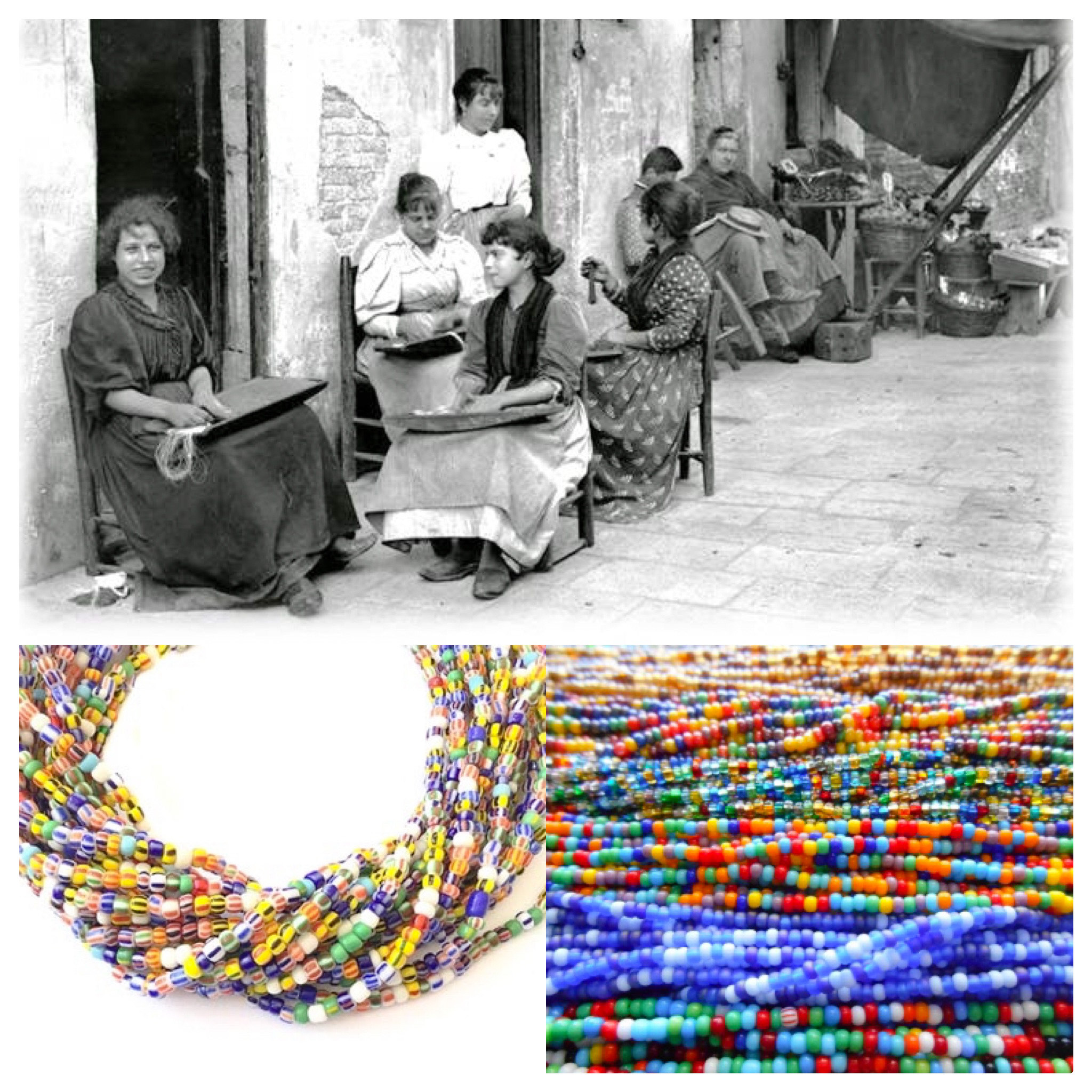
We are at the end of the nineteenth century and small glass beads were made in the Murano kilns: different sizes, an incredible color palette, so precious to be used also as a bargaining chip to buy spices, palm oil and even slaves. From here comes one of the oldest processes in Venice, exclusively feminine and uniquely crafted. Against the background of the Sestiere di Castello, the impiraresse, the stringers of these pearls, come together in a group of calluses, which create the magic of elegant and sophisticated necklaces, the charm of every woman. So called from the term impirar, to slip, the impiraresse carried out this work in their home, and if time allowed it, at the door of the house: this image of women gathered in a circle to insert glass beads is one of the oldest and most ancient postcards beautiful in the artisan history of Venice. United by the same hairstyle, that bun that kept their hair firmly and tightly gathered, called a cocon, they held in their lap large baskets in straw where they gathered the rainbow of pearls, while with their right hand they put them on a fan of needles 18 centimeters long held in the left hand. With this biblical patience, even 2-meter long wires were made to then create jewels to embellish the neck and decolté of the most elegant ladies. The entire "productive" process was managed by women only: impiraresse were headed by the mistre, the intermediaries who were responsible for finding the vitreous material from the island of Murano, for organizing the work and then selling the finished jewelery. Just think, we are only in the last years of the 1800s but emancipation and female entrepreneurship was already widespread in Venice. Pure avant-garde!
Today as then, Castello is still the realm of impiraresse and long colored threads, even if the modern bijouterie has unfortunately undermined this ancient process: giving a necklace in glass beads is like giving a piece of history of Venice and great craftsmanship that has always distinguished it over the centuries. I recommend, beware of the imitations and fakes that unfortunately circulate in the city, entrusting you to serious and professional dealers.
Treat yourself to Made in Venice!
Burano lace
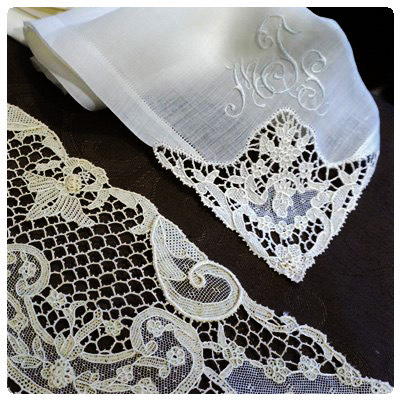
Often beautiful things have no motivation, they are beautiful only because they exist: there are no explanations or documents that motivate their birth. This is the case of Burano lace, whose birth is not written in the annals of the history of the Serenissima, but in a fascinating and romantic legend of love. Two young men from the Burano island are about to get married, she is a housewife, he is a good-natured fisherman. During an outing at sea the boy is tempted by the song and the sinuous body of the sirens, but the love for his woman is strong and remains faithful. A mermaid, fascinated by this strong feeling greets the young man with a tail blow on the water and from the foam of the sea comes a veil decorated with a precious lace with which to honor the bride. On the day of the wedding that lace arouses the envy of all the women of the island who try in every way to replicate that marvelous lace: that's how buranello lace is born. Legends apart, this particular artisan process spreads around 1500, when the "air point" is created with only a needle and thread. The diffusion is then due to the noblewomen of the Serenissima, the dogaressa Morosina Morosini first and then the countess Adriana Marcello, who thanks to their patronage succeed in bringing this precious work throughout Europe, even to the court of King Louis XIV of France: not there is a woman who does not aspire and desires to adorn her clothes with precious lace. An ancient art that today, as then, has been handed down from generation to generation among family women, unique as always. And like then, today in Burano it is not difficult to find groups of lacemakers who weave their precious lace outside their homes.
Today buranello lace does not only adorn clothes, but you can find it as an enrichment for home textiles, such as tablecloths and placemates, sheets and bedspreads, table centerpieces and fans, even to particular earrings to show off at all ages.
A precious gift for ladies of all ages.
Venetian masks, the ancient art of mascareri
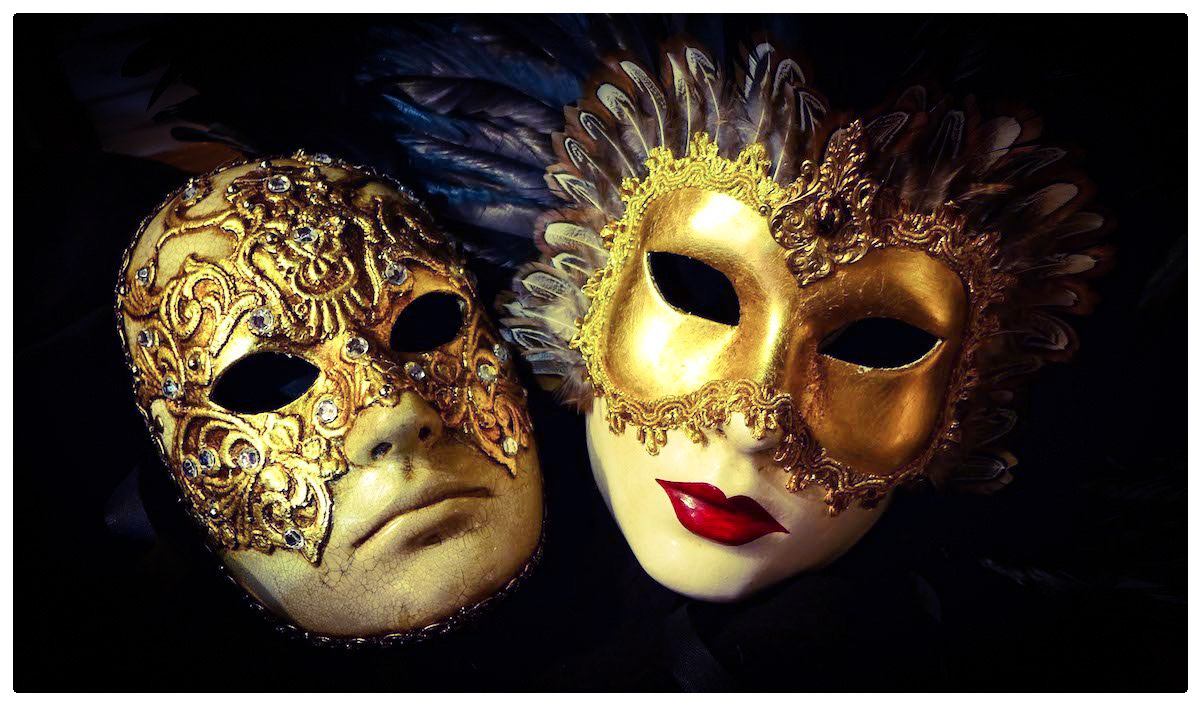
But do you know that the art of mascareri is one of the oldest professions in Venice? Oh yes, born around 1270. But the spread took place then thanks to the institution of the Carnival, which in Venice has always been a very serious thing, and above all long term. We are in the fifteenth century and the masks were the connotative element of the carnival festivities, behind which no one was recognizable, hiding any social and religious beliefs, sex and social status: that "good morning lady mask" was the greeting that cleared all differences, every distance. Even the Doge Francesco Foscarini endowed the mascareri with their own statute, the mariegola, to manage and administer the profession, still preserved today in the State Archive. The creation of a mask involved a long process with the use of various and precise materials: after a study on paper of the shapes and proportions, a model in clay was made; then the mold was created and for this the plaster was used; the cast was then covered with papier-mâché and gauze held together by a flour glue: once this mixture was dry, the mold below was removed and the mask was obtained. It was then finished at the edges and at the openings, then moved on to decoration: a riot of colors, precious stones, embroidery and high feathers.
Today, as then, this art has never changed: entering the workshop of a mascarere is like immersing yourself in a fairy world where a thousand faces with different shapes and colors scrutinize us silently, keeping the secrets of all the past stories in front of their hollow eyes firmly . Think that the great director Stanley Kubrick for his latest film "Eyes wide shut" chose a famous mascarere of Venice to make the masks of the famous scene of the masquerade ball to which Tom Cruise manages to infiltrate.
Today the most widespread masks, as then, are the bauta, the white mask with the particular shape of the pointed and protruding chin that gave the possibility to drink and eat without having to remove it from the face; the moretta, a dark velvet mask with a round shape that was supported on the face thanks to a button held in the mouth, used above all by women; that of the doctor of the plague, which in reality was used by doctors to visit the plague patients: it is a mask with a long aquiline beak that allowed to contain inside a filter made with salts and aromatic herbs, which "isolated" the doctor's sense of smell from the unpleasant odor that surrounded him, which over time then acquired a superstitious and exorcistic value with regard to illness and death; the classic oval mask, enriched with precious decorations.
Today giving a mask is a regal object of art to hang on the wall like a painting, precious and closely linked to the history of Venice.
For lovers of the genre.
Furlane in velvet, the tradition at his feet, for him and for her
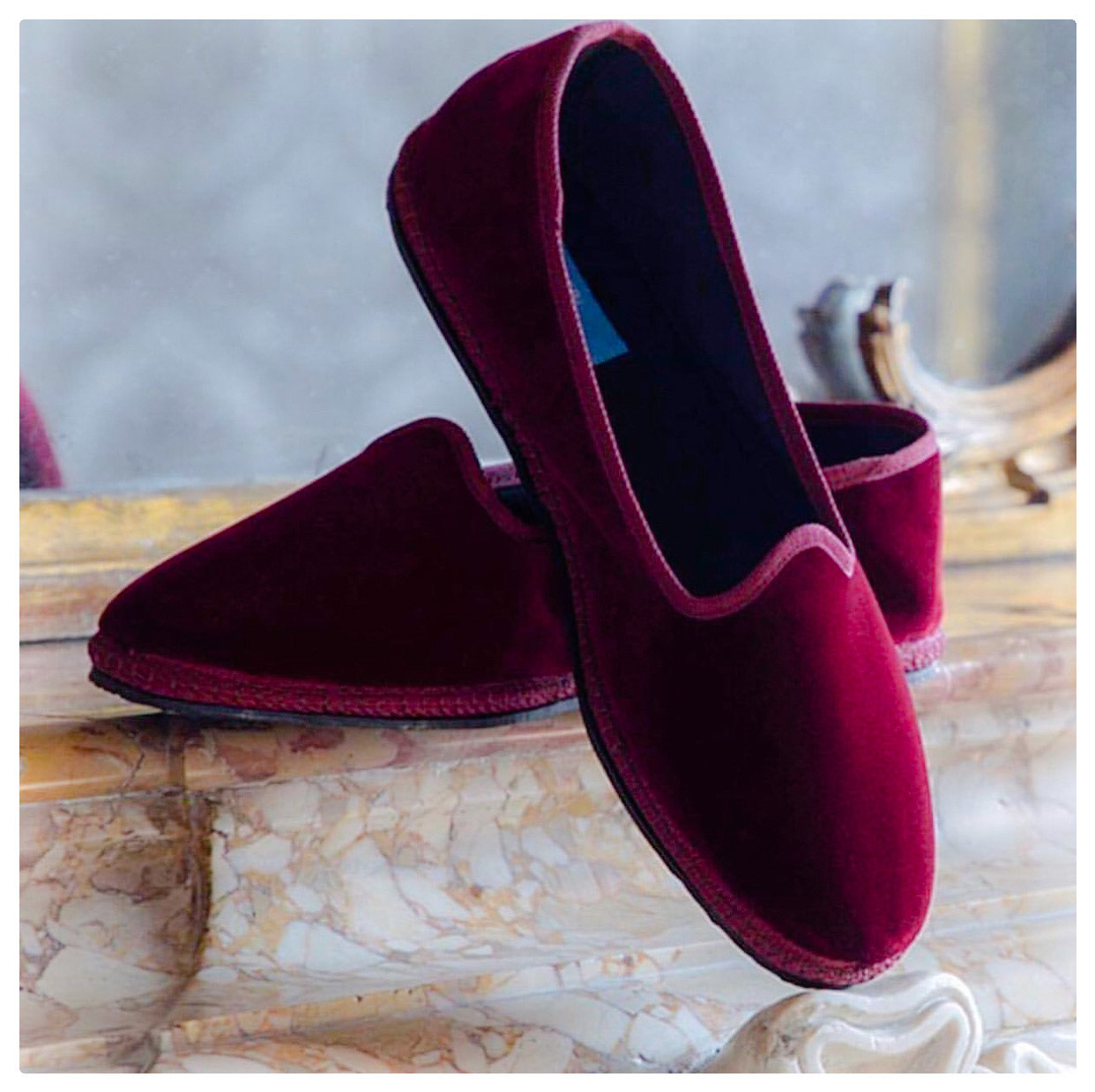
The art of recycling and the profound relationship between man and nature are the basis of the ancient tradition of furlane, particular shoes that you often see worn at the feet of gondoliers.
We are at the end of the second world war and the widespread poverty, especially in the countryside, made it impossible to buy the very expensive leather shoes. And it is precisely from the Friuli inland that this process is invented to satisfy a need, a need. The tires of disused tires began to be recycled for the realization of waterproof and resistant soles; the jute of the bags used for transporting legumes and seeds were used for stuffing, as the shoes also had to keep the foot warm; for the uppers, instead, the old clothes were reused. The shoes were all hand-sewn, perfectly functional and above all at very low cost, and soon they were well in demand. The Friulian peasants then understood that what was a personal need could become a trade. They began to produce and sell their products outside of their countryside and also arrive in Venice: here the Municipality allowed them to hold a stall for sale at the foot of the Rialto Bridge. The spread was very rapid thanks to the interest shown by the gondoliers: the delicate rubber of the sole was perfect for not ruining or scratching the paint of the gondolas. The union then with the precious oriental fabrics, such as velvet, damasks and silks made the furlane a true object of desire for everyone.
Today they are still handmade, often made to measure, but the recycling philosophy has been lost over the years: they are precious and elegant with their precious fabrics and the most disparate colors. And the kingdom of furlane is still Rialto, in memory of that stall from which everything started.
Giving a pair of furlane is giving an elegant and refined object, of those that make the difference, that make you remember.
To know more about all these products go to the handicraft in Venice section:
Traditional Venetian biscuits, for a very tasty gift
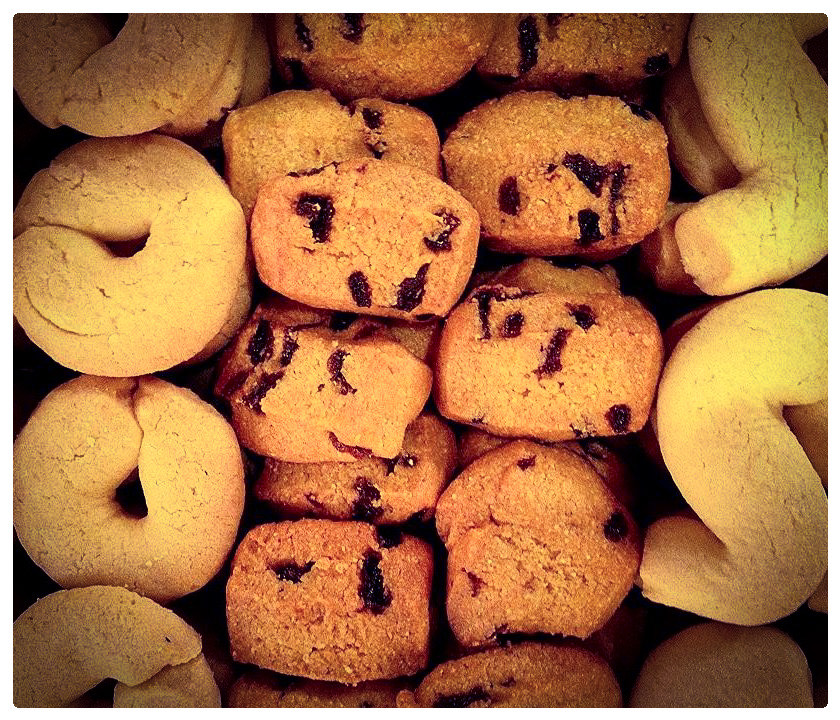
Christmas is that time of the year where it is easier to indulge in the calls of the throat and taste without feeling great remorse: we will think about it in the new year.
And there is always in the family that brother or that cousin more greedy of all to make happy with an equally delicious gift. The desserts of the Venetian tradition are products rich in nutrients, substantial and with the peculiarity of being able to be preserved for a long period, as they constituted the food of the sailors during the long sea crossings. These are, therefore, dry preparations, biscuits rich in butter and eggs, ideal for packing and taking home.
This Venetian pastry is characterized by the presence of spices: fragrant and colorful, with an unusual taste, they were brought to the Venetian land from the Far East, thanks to mercantile expeditions and commercial traffic that Serenissimi weaved with this part of the world. Thus it was that pepper, raisins, ginger, saffron, nutmeg, cinnamon, cloves began to make their way into the Venetian cuisine which became increasingly more fusion. The appearance in the Lagoon of the sugar dates back to the year 1000, brought by the crusaders, whose diffusion was then immediate thanks to the noble family Corner who bought whole sugar cane plantations between Cyprus and Crete, making it easier to use the finished product in the city.
To benefit from the union between fragrant spices and sugar was undoubtedly the pastry shop, worked by the scaleters, so they were called the ancient pastry chefs from the scalete, typical sweets of the now disappeared wedding.
Around the city you will find packages containing a selection of the most famous biscuits: the baicoli, which resemble toasted bread slices, are made with flour, eggs, butter, sugar and yeast in a single strand, are then cut into slices thin, they are very fragrant and good if tasted alone, but also mogiati (soaked) in coffee or zabaglione, and if you are greedy, covered with a veil of jam or spreadable chocolate; the zaeti (gialletti) whose name is due to the dialectal term zal which indicates the yellow color, in this case given by the presence of corn flour, which makes them extremely crunchy and scrocchiarelli, to which are added eggs, butter and sugar , vanilla and sultanas; the bussolà of Burano, so called because of their donut shape with the hole, called busà, are very friable biscuits due to the considerable presence of butter, and perfumed by their vanilla aroma: such is the scent that makes the air pleasantly sugary in the streets, and it seems they are used by the grandmothers to perfume the linen; pevarini, on the other hand, are characterized by a strong peppery note and prepared with a mixture of flour, molasses, lard, honey, yeast, black pepper, cinnamon, cloves and ginger, but today for practicality the molasses has been replaced with sugar and lard with butter: brown in color are certainly the most "oriental" sweets in the history of Venice.
A box of cookies to release the scents of the Orient under the Christmas tree.
Making a gift is a gesture of love. But also to acquire with awareness defending ancient arts and craft traditions is a gesture of love towards the past and present of the place we choose to visit, contributing to the construction of the future.
If we defend Made in Venice we defend Venice.










Lascia un commento